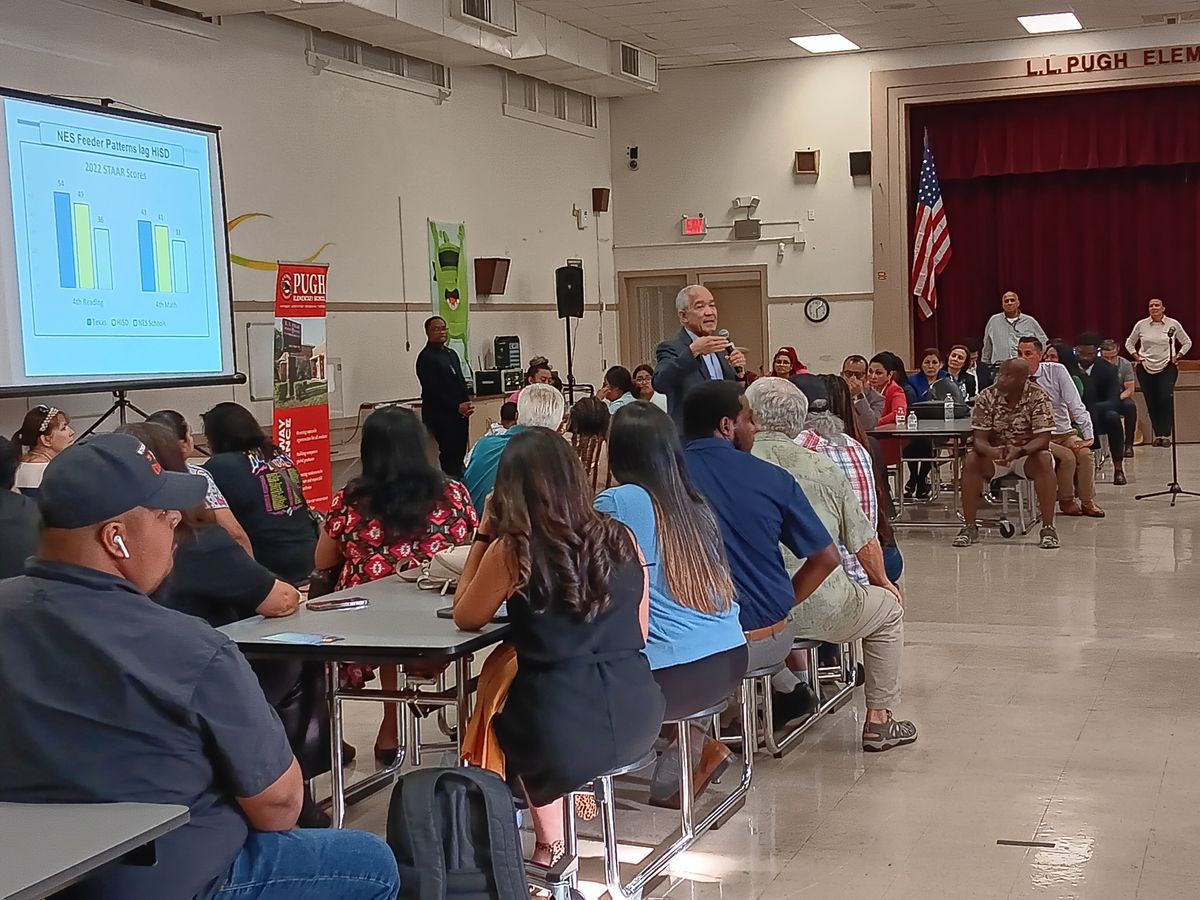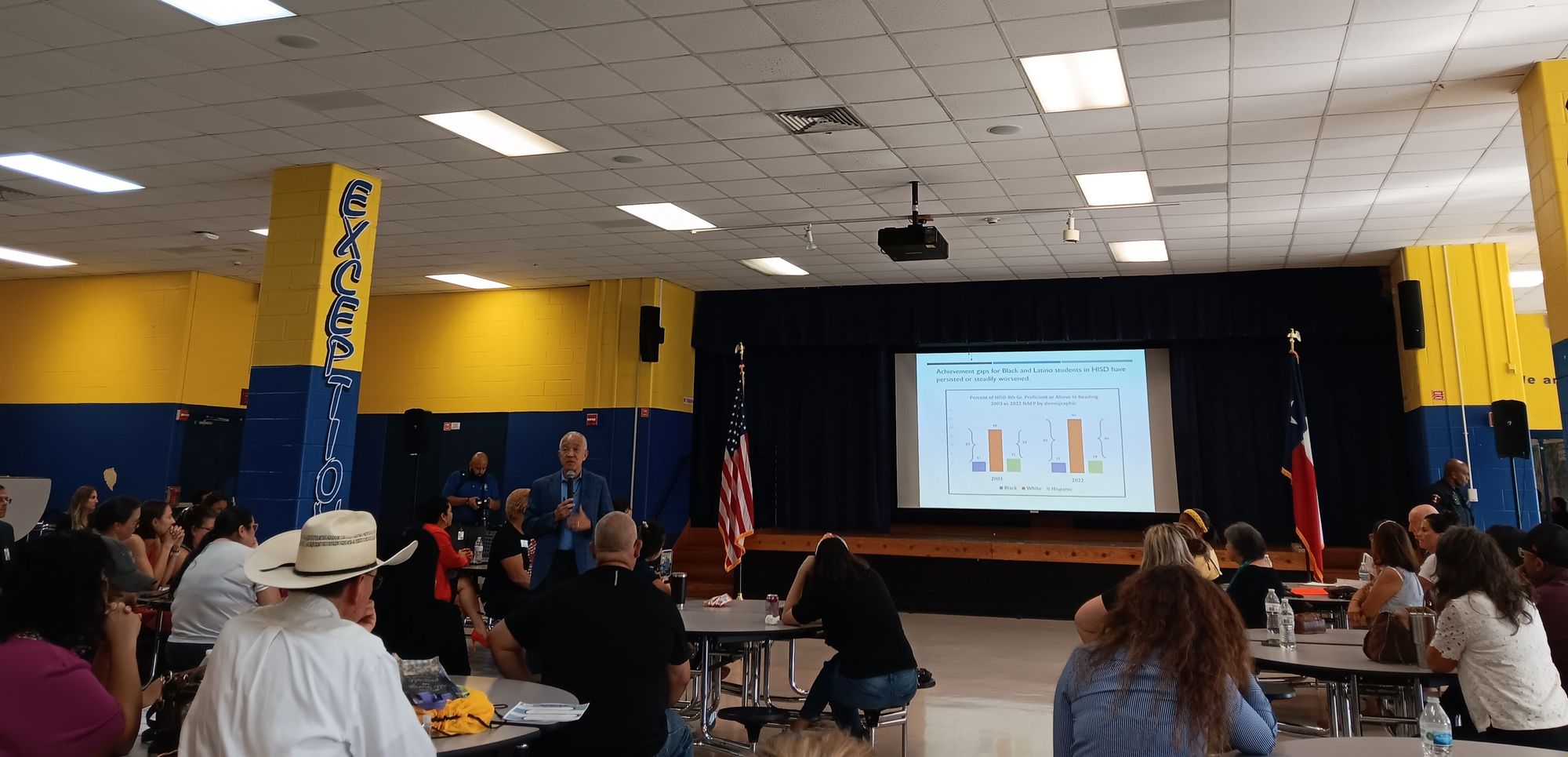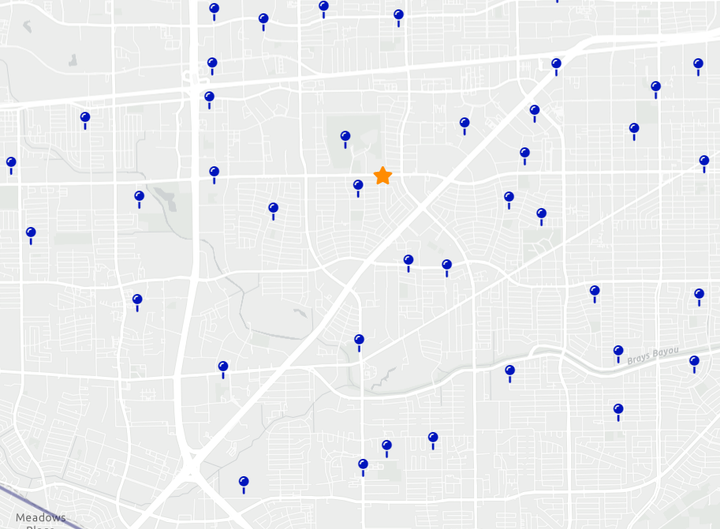Twelve Things HISD Plans to Change at Four Sharpstown Schools: the New Education System Explained

On July 27, HISD Superintendent Mike Miles will visit Sugar Grove Academy in Sharpstown to explain his “New Education System” (NES) to families and take questions. Parents from all HISD schools are invited to attend the meeting from 6:00-7:30 PM.
Can’t wait that long?
Never fear. Here’s how Superintendent Miles plans to transform the way four local schools teach, discipline, and serve students.
Sugar Grove is one of 28 NES schools across Houston. Three other Sharpstown schools—Bonham Elementary, Jane Long Academy, and Las Americas—opted to become “NES-aligned.”
What’s the difference between NES and NES-aligned? We’ll get there.
But first, here are twelve things that all NES and NES-aligned schools have in common, based on Superintendent Miles’ statements at two recent family meetings and press conferences: Pugh Elementary on July 11, and Marshall Middle School on July 13.
1. Support Staff Handle Prep and Grading So Teachers Can Focus on Teaching
It’s what Superintendent Miles calls the “hospital model” of staffing. Just like a surgeon doesn’t have to prep their operation room or take the patient’s temperature, a teacher shouldn’t have to prep their classroom, Miles says. Support staff like “apprentice teachers” and “learning coaches” will make copies, grade papers, and more. Meanwhile, teachers will have one main responsibility: teaching well in the classroom.
2. Teachers Don’t Make Their Own Lesson Plans
Teachers will be required to use standardized lesson plans and curriculum provided by the district, including pre-made PowerPoint presentations, assignments, and answer keys.
Not everyone likes this. Christina Longofono, a high school social studies teacher, stepped up to the microphone in the Marshall Middle School cafeteria to say, “It feels like disrespect.” To her, Superintendent Miles’ plan sends that message that “I can’t be trusted as a professional to make my own lessons.”
Later that evening, she said that she knows her students and adapts her lesson plans to their needs, and she’s worried the NES would hinder that.
But Miles says this system won’t turn teachers into inflexible robots: “They can always tweak [the lesson plan] and make it their own.”
What does that look like? At the press conference after the Pugh meeting, Miles gave an example: when kids read a small article as part of a lesson, the teacher can “make their own questions” arising from that article.
According to Miles, when he’s given teachers pre-made lesson plans before, “Teachers love it.”
3. Teachers Get More Oversight and Feedback
At Pugh, Miles said principals and assistant principals will be “in your classrooms all the time coaching [teachers] like a coach on the football field.”
He said that currently, principals are required to spend too much time filling out paperwork, and that’s like “a coach being asked to report on the size of the cleats.” He wants to change that.
Teachers and principals will also be subjected to a new evaluation system, which Miles says will allow HISD to “know for sure who’s highly effective and who’s not.” He only wants “highly effective” teachers at NES schools.
4. Administrators Discipline Students Based on Three Firm Rules
Superintendent Miles called these rules “sacrosanct,” meaning that violations by students will not be tolerated:
- “No disrespect to any adult.”
- “Cannot disrupt the learning environment.”
- “No bullying.”
5. Rule-Breaking Students Get Pulled from Class and Sent to “Team Center”
Miles plans for administrators to handle discipline so teachers don’t have to. If a student breaks one of the three rules, they will be pulled out of the classroom. School officials will talk to them and call their parents if necessary. But that’s not all.
Miles said that “teachers hate” when a student with behavior issues gets sent right back to the classroom. So in NES schools, the offending student may be sent to the “team center” instead, where they rejoin class via Zoom.
Miles’ discipline methods may sound strict to some—and he does have a military background—but he also emphasizes that good discipline starts with a “culture of care”: teachers and administrators caring about students.
6. HISD Will Install Webcams and Smart Boards in All Schools
Between 28 NES schools and 57 NES-aligned schools, that’s a lot of technology to install. But Miles said at Pugh, “We’re committed to doing all 85.”

7. Schools Will Use New Curriculum that Prioritizes Reading in English
The new reading curriculum, Amplify, emphasizes “the science of reading,” a phonics-based reading method (as opposed to the sight-reading and cuing methods that became an education fad in recent decades).
Miles said kids “will take the first part of ELA [English Language Arts] in English no matter what,” but then teachers will “supplement” in Spanish for kids who speak Spanish.
For more on phonics versus sight reading, see the Sharpener’s Q&A with Principal Amanda Wingard.
8. Community Members Will Teach “Dyad Classes”
Twice per week, students will take “dyad classes,” which will expose them to a variety of subjects such as “martial arts, photography, and dance.” Miles wants most dyad classes to be taught by members of the local community who will be located by HISD community coordinators.
9. Students Learn “Year 2035 Competencies”
Miles says that NES schools will prepare students for our rapidly changing world by teaching them critical thinking, problem-solving, teamwork, and even how to work with AI: “Students need to learn how to learn and learn how to think rather than what to think.”
According to the NES FAQ webpage, NES schools will even have positions for “Art of Thinking” teachers.
10. Eligible Students Take up to Two Educational Trips at HISD’s Expense
Miles wants eligible 7th-graders to travel out of state, and eligible 8th- and 9th-graders to travel out of country. He says that all expenses will be paid for students and chaperones: HISD will even help students get their passports if necessary.
11. Schools Will Be Open Longer
Instruction time will be from 8:00 AM to 4:00 PM, but the school doors will be open from 6:30 AM to 5:00 PM. Miles said this move was designed to help parents who work early shifts: “You can drop your kid off, they’ll be safe, you can get to work.”
12. Many Employees Will Receive a $10,000 Stipend on Top of Their Base Salary
The stipend is available for teachers, principals, assistant principals, counselors, reading interventionists, English Learner Development (ELD) interventionists, special education support, and deans of students.
The Difference Between NES and NES-Aligned
So far, everything said will be true of both NES and NES-aligned schools. But there are two things that will happen in NES schools (like Sugar Grove), but not in NES-aligned schools (like Bonham, Jane Long, and Las Americas):
- The minimum base salary for teachers at NES schools will jump higher. (For example, a 6th-grade NES Science of Reading teacher will make at least $86,000 per year.) But the base salary for teachers at NES-aligned schools will remain the same.
- NES schools have already been “reconstituted,” meaning all their teachers and principals had to reapply to their jobs, and some were not rehired. NES-aligned schools will not be reconstituted, but two NES-aligned principals are being replaced anyway.
Big Plan, Results Unknown
Altogether, that’s fourteen things that Superintendent Miles plans to change in NES schools, and twelve in NES-aligned schools.
It’s a bold—and controversial—vision. And he says that, if necessary, he’s willing to dip into HISD’s fund balance (money the district keeps in reserve) to pay for it.
But at this point, the plan is still just that—a plan. Will it work? And will it be implemented in the same way at every NES school?
Time will tell. When HISD classes begin on August 28, Sharpstown will get to see the NES in action.



Comments ()